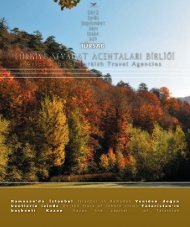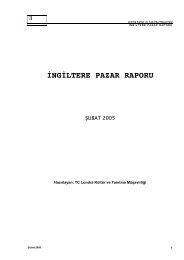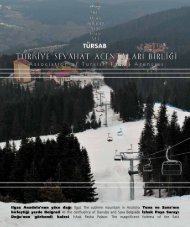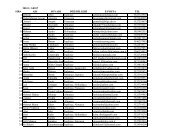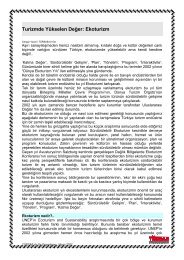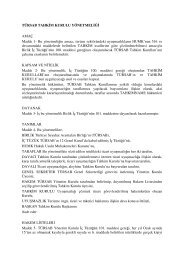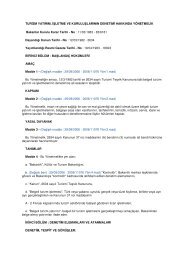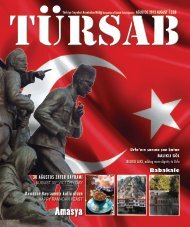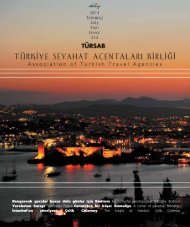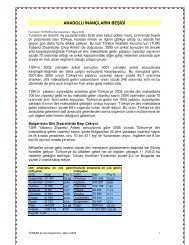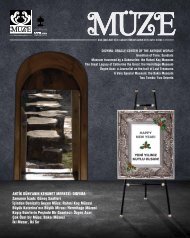‹çindekiler Contents - Türkiye Seyahat Acentaları Birliği
‹çindekiler Contents - Türkiye Seyahat Acentaları Birliği
‹çindekiler Contents - Türkiye Seyahat Acentaları Birliği
Create successful ePaper yourself
Turn your PDF publications into a flip-book with our unique Google optimized e-Paper software.
Ankara şehrindengenel bir görüntüA general viewfrom the city ofAnkaraHititlerin ya da Romalılarındönemindeki yapılar artık tarihikalıntılardan ibaret. Selçuklulariz, Osmanlılar ise miras bırakmış.Günümüzde kale içinde çoksayıda eski Ankara evi var. Araziyapısının gereği, daracık evleryan yana inşa edilmiş. İki ya daüç katlı evler ahşap ya da kerpiç.Alt katlar, evin “kış köşesi” olarakkalın duvarlı ve küçük pencerelithe names of their emperor, coat ofarms, sultan’s signature on gatesopening onto the living quarters of thesquare.As far as it is known, the first time thecity expanded out of the castle wasafter the Roman invasion around thebeginning of 2BC. The castle, stayed“within” the city, instead of embracingit. Clearly the term “Kaleiçi” isreminiscent from those days to today.Bay windowed “cihannüma”s*(*gazebos)Of course, the houses in the courtyardof the castle don’t date beyond a coupleof centuries. Only the ruins of buildingsfrom Hittite or Byzantine era remain.Seljuks have left their traces, Ottomansleft their heritage. Today there arenumerous Ankara houses in the innercourtyard. Because of the lay of theland, narrow houses were built next toeach other. Two or three storey mudbrick or timber houses. Lower floorswere built with thick walls and smallwindows to act as the “winter corner”.Upper floors on the other hand had baywindows, were more airy and built with“cihannüma”s (gazebos).Most detailed information aboutAnkara’s inner courtyard houses wasgiven by Evliya Çelebi. Passing throughAnkara in 1640, the famous travellerhad this to write about Ankara:“Ankara has a strong castle built onfour levels of white stone on top a highhill. The castle has three inner walls.The inner castle is surrounded byrocks. It is difficult to climb over thesesheer faced rocks. There are guns,various armoury, ammunition and 600houses in the inner castle.”Today its tourism’s castleSettled over such a large area, even inthe middle of 17 th century, the innercastle is one of the most importanttourism stops in today’s Ankara. Oldmansions were converted to elegantrestaurants, especially after theinitiative for restoration. Rooms insome of the houses in the courtyardstarted to serve as an antique or agift shop. Some of the big mansionswere preserved as museums, openingtheir doors to those who came towitness Ankara’s rich history. Thehistorical caravanserai known as the“At Pazarı” (Horse Market) is nowÇengelhan Rahmi Koç Museum. Builtin 18 th century, three storey timber“Pirinç Han” used to host tiredtravellers; nowadays it is hostingantique collectors. And many morestops: Davulcular Hanı (DrummersInn)... Arslanhane (Lion House)...Ahi Şerafettin Türbesi (Shrine ofAhi Şerafettin)... historical waterfountains, remains of columnshidden in narrow streets which evena car would pass with difficulty...The inner castle is a black box inmany ways. It hides voices of people,smells, textures that belong tocivilizations coming through this landand shares it generously with thosewho want to see and find out. Almostan open air museum, it is selflesslytelling the incredible tale of history.22 TÜRSAB DERGİ | HAZİRAN 2010



